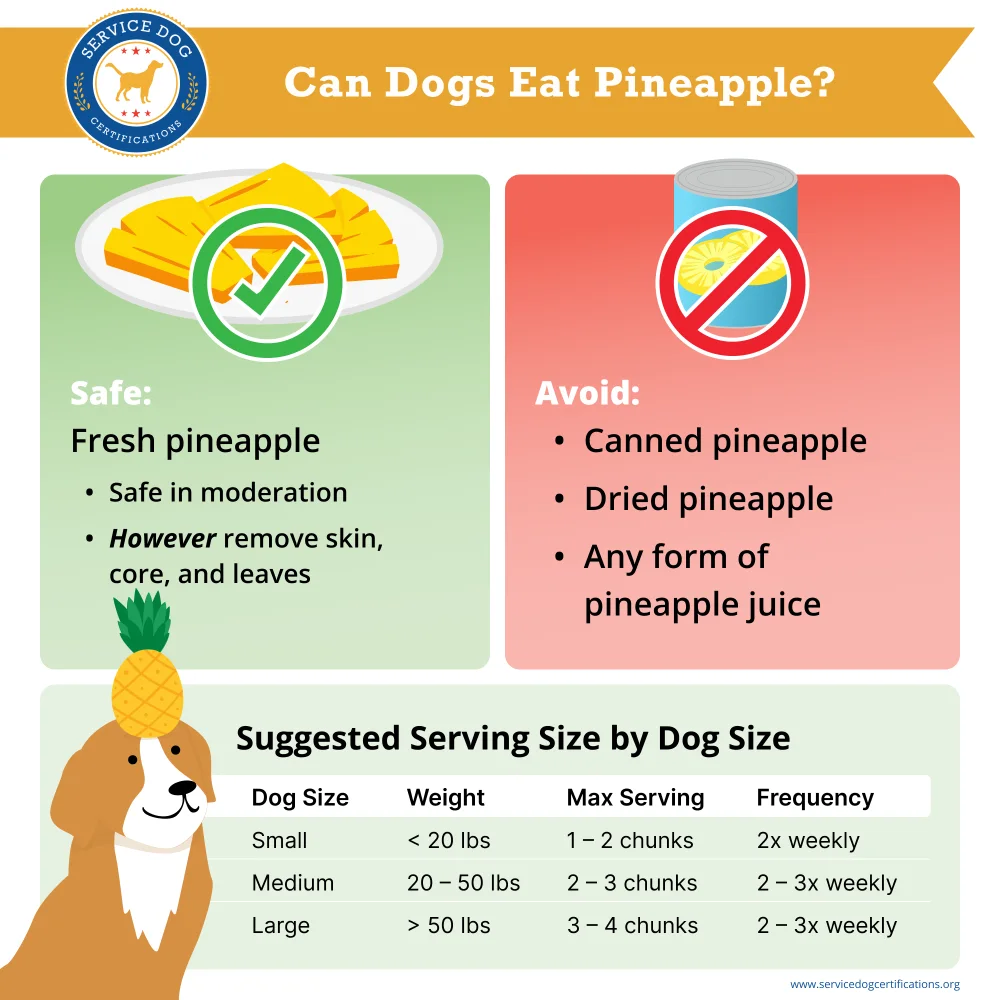Can Dogs Eat Pineapple?

Yes, dogs can safely eat fresh pineapple in moderation. This comprehensive guide combines scientific research with practical advice to help you safely share this tropical fruit with your canine.
Share this image on your site
Nutritional Benefits of Fresh Pineapple
Fresh pineapple packs a powerful nutritional punch that can benefit your dog’s health:
- Vitamins and Minerals: Rich in vitamin C, B6, folate, and minerals like manganese and potassium
- Hydration: High water content (around 87%) helps keep your dog hydrated
- Fiber: Contains dietary fiber that supports digestive health
- Antioxidants: Offers beneficial compounds that help fight inflammation
- Natural Enzymes: Contains bromelain, which can aid digestion
Types of Pineapple Compared
Comprehensive Comparison Chart
| Type | Sugar Content | Safety Rating | Why |
|---|---|---|---|
| Fresh | 10g/100g | ✅ Safe | Natural enzymes intact, balanced nutrients |
| Canned | 32g/100g | ❌ Avoid | High sugar, preservatives, lost nutrients |
| Dried | 40g/100g | ❌ Avoid | Concentrated sugars, additives, choking risk |
| Juice | 13g/100ml | ❌ Avoid | No fiber, concentrated sugars, dental risks |
Safe Serving Guidelines
The American Animal Hospital Association and veterinary nutritionists recommend following the 90/10 rule: treats, including fruits like pineapple, should make up no more than 10% of your dog’s daily caloric intake.
Pineapple should be an occasional treat, not a daily food. Too much can lead to:
- Stomach upset
- Diarrhea
- Blood sugar spikes
- Tooth decay due to natural sugars
Portion Sizes by Dog Weight
| Dog Size | Weight | Max Serving | Frequency |
|---|---|---|---|
| Small | < 20 lbs | 1 – 2 chunks | 2x weekly |
| Medium | 20 – 50 lbs | 2 – 3 chunks | 2 – 3x weekly |
| Large | > 50 lbs | 3 – 4 chunks | 2 – 3x weekly |
Preparation Steps
Only the soft, fleshy part of the pineapple is safe for dogs. You must remove:
- The tough outer skin
- The hard core
- The sharp crown/leaves
- Any remnants of the spiky exterior
These parts can cause choking or digestive blockages if consumed.
Health Considerations
When to Avoid Pineapple
For health reasons, certain dogs should not consume pineapple:
- Dogs with diabetes (due to sugar content)
- Dogs with known fruit allergies
- Dogs with sensitive digestive systems
- Dogs on specialized medical diets
Warning Signs
Watch for these symptoms after feeding pineapple:
- Vomiting
- Diarrhea
- Lethargy
- Loss of appetite
- Excessive thirst
- Allergic reactions (rare)
If you notice any of these signs, discontinue feeding pineapples and consult your veterinarian.
The Bottom Line
Fresh pineapple can be a safe and healthy treat for most dogs when served properly. The key points to remember are:
- Moderation is crucial
- Only serve the flesh
- Prepare it properly
- Monitor your dog’s reaction
- Consult your vet with concerns
By following these guidelines, you can safely share this tropical treat with your canine companion and add variety to their treat routine.
Frequently Asked Questions
How much pineapple can I give my dog?
Follow the 90/10 rule: treats (including pineapple) should make up no more than 10% of your dog’s daily caloric intake. For most dogs, 2-3 small chunks are plenty.
Can puppies eat pineapple?
Yes, but introduce it very gradually and in tiny amounts to avoid digestive upset.
Is pineapple good for dogs with constipation?
The fiber and water content may help, but consult your vet for proper constipation treatment.
Can dogs eat pineapple core?
No, the core is too tough and fibrous, potentially causing choking or digestive blockages.
About the Author: The writing team at Service Dog Certifications is made up of folks who really know their stuff when it comes to disability laws and assistance animals. Many of our writers and editors have service dogs themselves and share insights from their own experiences. All of us have a passion for disability rights and animals.
Related Articles

Benefits of a Raw Food Diet for Dogs
Diet is a very important part of keeping your dog healthy. There have been many articles about dog food made in China that had harmful ingredients. A raw food diet is the most natural and healthiest way to feed your favorite canine. Here are a few arguments about feeding your dog a raw food diet. […]

Read More

Can You Deduct Service Dog Veterinary Bills on Your Taxes?
Yes, service dog vet bills are tax-deductible medical expenses. Food, grooming, training costs, and equipment all qualify, too. The only catch is that your dog needs to be an actual working service dog. Expenses for regular pets and emotional support animals don’t count, no matter how much comfort your animal provides. The government wants proof […]

Read More

Should I Vaccinate My Service Dog?
Yes, you should vaccinate your service dog, as they are required by many state and local laws to be vaccinated, just like a pet dog. Additionally, vaccinations like rabies are required for air travel. Just because your dog is a service dog does not exempt them from vaccinations, unlike it does for pet fees and […]

Read More

